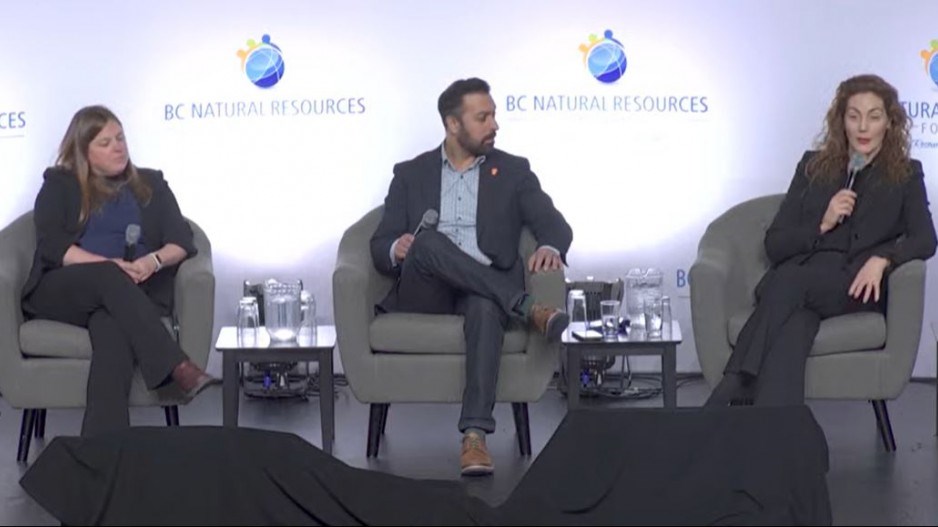Some of the mines now operating in B.C. would have been initially financed, when still exploration projects, by retail investors.
But the junior resource sector has had to find alternative ways to finance their companies and projects, a panel on financing in the resource sector heard Thursday at the BC Natural Resources Forum.
Asked where the money is today, Kimberly Burns, resource lawyer at Denton’s Canada, said: “I'm gonna skip right over where the money is not, and that is in the traditional retail and capital markets.
"I have yet to find anyone that can look me in the eye and choose to say, 'yes, 2024 is the year that retail investors are coming back to the resource industry.'
“We see money available in private equity. And by private equity, I mean everything from local family business that's looking to invest their generational wealth, to the largest global private equity funds that are using Canadian resources as part of their portfolios.
“Now, if you are a revenue positive business in the resources sector in Canada, private equity across North America is looking at you. They're analyzing you and they're thinking about you. And if you haven't had the call of a reach-out, it's on its way.”
She said resource companies looking for private equity investment in Canada should ensure they have good relations and partnerships with First Nations.
“You need strong positive engagement and you need, ideally, strong positive endorsement from the indigenous groups and the nations that are in your community.”
Kendra Johnson, managing director at investment fund manager PearTree, and former CEO of the Association of Mineral Exploration (AME), agreed that retail investors have largely fled the resources scene.
“If we go back 10, 15 years, we used to see a lot of money coming from the retail sector and, to Kimberly's, point that money is not there anymore,” she said.
“It dried up five, six years ago at this point. And at that time, we saw a real transition into traditional flow-through funds, and flow-through is one of the things that has been an incredible success from a physical policy perspective, both federally and provincially.”
Flow-through shares are a financial instrument that appears to be unique to Canada and largely used by the junior mining sector. They are investments in which the investor gets to claim a tax deduction equal to the amount invested, according to the Prospectors and Development Association of Canada (PDAC).
Johnson said junior miners listed on Canadian stock exchanges raise about $1.3 billion in a given year.
“Approximately 83 per cent of that is raised through the flow through regime,” she said.
Another more recent financing mechanism is the federal government’s new critical minerals tax credit, which Johnson characterized as “a resounding success.”
“The resounding success that that program has had in the first 18 months -- so from the time it was announced in April 2022 through to the end of 2023 -- there was over $500 million raised for critical mineral projects across the country,” Johnson said.
But the federal government giveth and taketh away. Johnson warned that proposed amendments to the federal alternative minimum tax will claw back some of capital raised through the new critical minerals tax.
“Really what that's going to do is it's going to impact the very few... people who are raising funds for critical minerals in Canada,” she said.
“I don't think it was intentional to have it impact the critical minerals tax credit in the way that it's going to. But at the end of the day, the ultimate impact that it's going to be is a reduction of about 30 per cent of investment coming into critical minerals through that critical minerals tax credit.
“So that $500 million that was raised -- had the new proposed rules been in place -- going forward would have resulted over the last couple years to be about $333 million instead of the $500 million.”
Another source for financing may come from First Nations, which are increasingly inclined to take equity positions in resource projects. On Wednesday, for example, Defense Metals Corp. (TSX-V:DEFN), which is developing the Wicheeda rare earths project near Prince George, announced that the McLeod Lake Indian Band is taking a one per cent equity stake in the company.
First Nations have been more active in Alberta, thanks to a loan guarantee program there, according Jameel Sayani, Northern BC Provincial Director (BC), Indigenous Services for MNP.
“In Alberta, they have something called the Alberta Indigenous Opportunities Corporation, where First Nations can go raise capital with a loan guarantee," he said. "We're hoping for the same same kind of thing to happen in B.C. eventually.”




